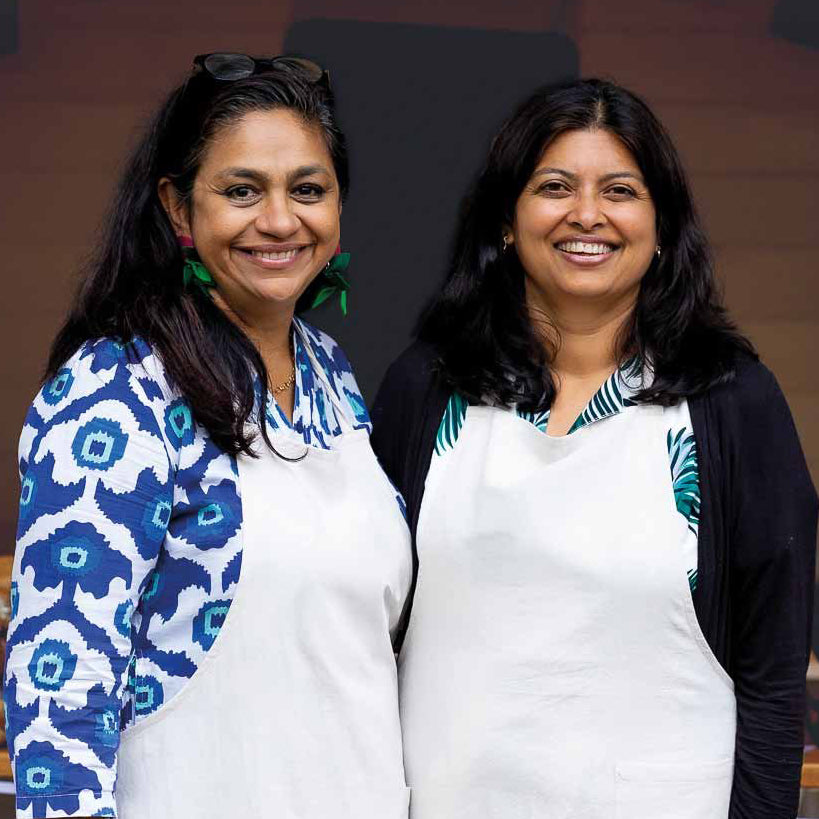In my late teens, I went to live with my uncle, who was Muslim, and my aunt, who was Buddhist. I’d grown up Christian — so between us, it was a full house of faiths, stories, and traditions. But what tied it all together was the joy of celebration. That home was always full — of laughter, of warmth, of people coming and going, and plates that were never empty.
It was there that I experienced my first proper Avurudu. April turned into a season of togetherness. We’d eat until we couldn’t move, the aunties would take over the house with their opinions and snacks, and someone would always end up blindfolded in the garden, giggling, trying to smash a clay pot. It was chaotic, it was joyful, and it made me feel deeply connected — like I’d found my place in something bigger
It’s loud, colourful, a little chaotic — and I wouldn’t have it any other way.
This is Sri Lanka’s real New Year. No countdowns, no fireworks, just ancient timings based on astrology, pots of milk bubbling over (on purpose), and enough snacks to feed your entire neighbourhood. It’s about reconnecting — with family, with tradition, and with our roots.

Back to basics: old-school games and childhood flashbacks
Avurudu is the one time of year the whole extended crew gets together — cousins, second cousins, and that aunty who isn’t technically related but always brings something tasty. You play all the old games: pillow fights on a log with one hand tied behind your back (yes, really), a giant tug of war, and the legendary pot-smashing game where someone shouts directions while you stumble around like a lost chicken.
The vibe is somewhere between school fête and sports day, with a lot more coconut.
Dressed by astrology
Every year you’re told the colour to wear, sometimes different colours for the different traditions (white for boiling the milk) yellow for lighting the lamp all based on astrological charts. And every year, someone forgets and shows up in blue instead of yellow, triggering minor drama and sharp looks from the elders. Standard.

A moment of tradition: honouring beginnings and blessings
The first act of Avurudu morning is lighting the hearth and boiling a pot of milk until it overflows. And yes — it’s meant to overflow. That milky froth bubbling up and spilling over is a beautiful (and slightly chaotic) symbol of abundance and prosperity for the year ahead. Everyone crowds around, someone’s always shouting “it’s going!” like it’s a national event, and for a minute, time slows down.
At the given time, comes the lighting of the oil lamp. A quiet pause. One flame passed hand to hand, lighting the way for the year to come. After that, we move into one of the most heartfelt Avurudu customs — offering betel leaves (bulath) to our elders. You kneel, offer the leaves, and receive their blessings in return. Hands on your head, words softly spoken — a proper reminder that everything we celebrate today is built on the love, sacrifice, and wisdom of the ones before us.

The food. My goodness, the food.
The Avurudu table is a true centrepiece. Here's a taste of what you'll find:
-
Kiribath – soft, comforting milk rice that everyone loves (and no one can stop eating).
-
Chicken Curry – made using our Chicken Curry Kit, naturally.
-
Mustard Fish Curry – tangy, spicy, and ready in twenty minutes — perfect when visitors just “drop in”.
-
Onion Sambol – fiery, zesty and not for the faint-hearted. We’ve got a video demo for that, by the way.
- Cashew and Pea curry- enough said.
-
Kavum – deep-fried treacle cakes. Personally? Not my fave. But thankfully, the table's got plenty to choose from.
-
Kokis – those beautifully crisp, flower-shaped bites that look fancy but taste like posh crisps. Not sweet, not spicy, just ridiculously moreish. And if you’ve ever tried making them, you’ll know getting them off the mould is an extreme sport. Shoutout to the aunties who do it like it’s nothing.
-
Mung Kavum – my absolute favourite. Sweet little pillows of mung bean paste wrapped in rice flour and deep fried. Like a tropical flapjack-doughnut hybrid.
-
Athiraha – soft, mellow, cake-like squares made with rice flour and kithul treacle. Gently steamed or cooked until just sticky enough.
-
Milk Toffees – rich, chewy squares made with condensed milk and cashews. If there’s a Tupperware of these going round, best believe they won’t last long.
-
Coconut Toffee – similar to milk toffee but with added coconut and a bold pink (or green!) colour that screams Avurudu pride. Sticky in the teeth, sweet on the soul.
-
Thalaguli – dense little sesame and jaggery rolls, usually wrapped in white oil paper with the ends all fringed. Nutty, earthy, and a proper grown-up sweet.
-
A fresh hand of bananas – one of the only things on the table not soaked in treacle or fried in oil. Soft, ripe, and perfectly sweet on their own.
-
Tea with hakuru – strong, plain Ceylon tea with a little palm jaggery on the side. You pop it in your mouth and sip your tea through it. No frills. No milk. Just mellow, warm goodness.
Honestly, the sweet table deserves its own postcode.
Want to try it at home?
You can! Pair our Chicken Curry Kit Mustard Fish Curry Kit Cashew nut and Pea curry kit, I will be posting our simple recipes for kiribath (milk rice) and Seeni Sambol (sweet onion relish) on Wednesday so watch out for that on Instagram, and you’ve got the makings of an Avurudu spread worthy of any celebration.
So what’s the vibe this year?
Whether you’re in Sri Lanka or not, lighting the oil lamp with your nan or blasting tunes while cooking for your mates – this celebration is about more than tradition. It’s about togetherness. It’s about pausing for a moment, sharing food, laughing over old stories, playing ridiculous games, and accepting your fourth serving of milk rice because saying no just isn’t an option.
From our kitchen to yours – Suba Aluth Avuruddak Wewa and Iniya Puthandu Nalvazhthukkal. May your curries be rich and your heart be full.


